
Man spent many millennia comprehending the fact that the Earth is not the center of the universe and is constantly in motion.
Galileo Gallilei’s famous declaration “And yet it rotates!” has eternally cemented itself in history and has become a symbol of the era when scientists from various countries attempted to disprove the geocentric theory of the world.
Although the Earth’s rotation was proven approximately five centuries ago, the precise factors that drive its movement remain unknown.
During the Middle Ages, there was a widespread belief that the Earth remained still while the Sun and other planets orbited around it. It was not until the 16th century that astronomers were able to provide evidence to the contrary. Although Galileo is often credited with this revelation, it was actually another scientist, Nicholas Copernicus, who made this groundbreaking discovery.

In 1543, he authored the treatise “On the Circulation of the Heavenly Spheres,” presenting the hypothesis of the Earth’s motion around the Sun. Initially, this idea faced resistance from both his peers and the church. However, it ultimately had a profound impact on the scientific revolution in Europe and played a fundamental role in the advancement of astronomy.
Following the confirmation of the Earth’s rotation, scientists began to investigate the causes behind this phenomenon. Throughout the centuries, numerous hypotheses have been proposed, yet to this day, no astronomer can provide a definitive answer to this question.
At present, there exist three primary versions that possess the right to existence – theories regarding inert rotation, magnetic fields, and the influence of solar radiation on the planet.
The theory of inert rotation
Several scientists are inclined to believe that in the past (during its formation and emergence), the Earth spun itself and currently rotates due to inertia. Originating from cosmic dust, it began to attract other celestial bodies, which contributed to its additional momentum. This assumption can also be applied to other planets within the solar system.
The theory faces opposition from many due to its inability to clarify why the Earth’s velocity varies during different periods. Furthermore, it remains uncertain why certain planets within the solar system revolve in the opposite direction, such as Venus.
The concept of magnetic fields

When attempting to connect two magnets with the same charged pole, they will experience a repulsive force. The theory of magnetic fields suggests that the Earth’s poles are similarly charged and repel each other, resulting in the planet’s rotation.
What is intriguing is that scientists have recently made a remarkable revelation that the Earth’s magnetic field propels its inner core in a west-to-east direction, causing it to spin at a faster rate than the rest of the planet.
The most likely explanation is the theory of solar radiation. It is common knowledge that the Sun warms the Earth’s surface layers (such as the air, seas, and oceans), but this heat distribution is not uniform, leading to the creation of air and sea currents.
These currents, when they interact with the Earth’s solid shell, cause it to rotate. The continents function as turbines, dictating the speed and direction of movement. If they are not sufficiently solid, they will begin to drift, which can impact the speed of rotation.
The phenomenon that causes the Earth to revolve around the Sun is known as inertia. According to the hypothesis regarding the origin of our star, approximately 4.57 billion years in the past, an immense quantity of dust materialized in outer space, which gradually transformed into a disk shape and eventually coalesced to form the Sun.

The dust particles on the outer edge of this cosmic debris began to come together and form planets. At that moment, they started to orbit around the star due to their momentum and continue to follow the same path to this day.
According to Newton’s law, all celestial bodies move in a straight line, which means that technically the planets of our solar system, including Earth, should have already drifted off into outer space. However, that is not the case.
The reason behind this is the Sun’s massive size and correspondingly immense gravitational force. As the Earth moves, it constantly tries to escape in a straight line, but the gravitational pull keeps drawing it back, thus keeping the planet in its orbit and causing it to rotate around the Sun.
It is a well-known fact that the Sun is at the center of our solar system and that the Earth orbits around it. However, there is still much mystery surrounding the mechanisms and reasons behind this celestial phenomenon, and even scientists have yet to provide a definitive answer.
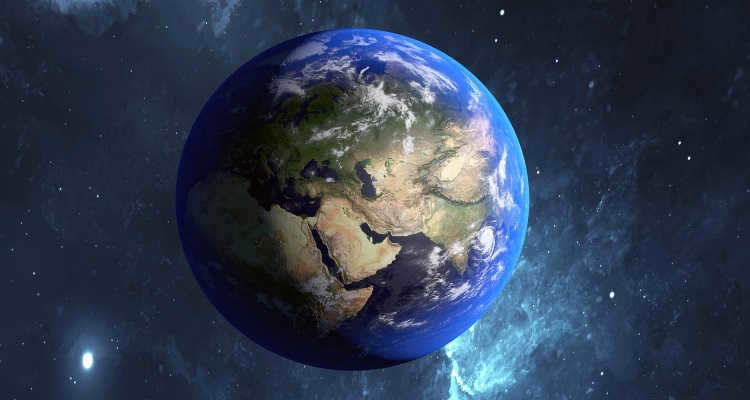
Earth or Sun: Which one rotates?
In the past, it was commonly believed that the Earth remained stationary while the Sun and other local planets orbited around it. However, this notion was debunked in the 16th century. Many people mistakenly attribute this scientific breakthrough to Galileo Galilei, as he famously declared, “And yet it goes round!”
Nevertheless, the credit for this discovery actually goes to Nicolaus Copernicus. In his work titled “On the Circulation of the Heavenly Spheres,” published in 1543, he proposed the theory that the planets revolve around the Sun, rather than all celestial bodies revolving around the Earth.
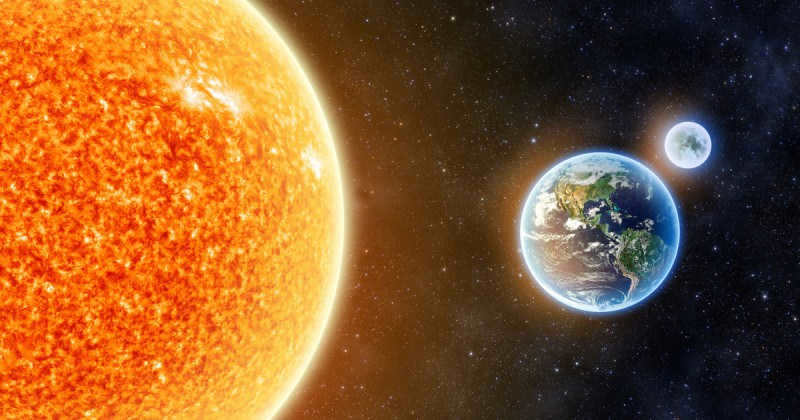
Initially, the validation of the solar system’s planetary rotation theory was achieved, after which astronomers embarked on uncovering the underlying causes of this phenomenon.
Over the past centuries, numerous hypotheses have been proposed, yet up to the present day, no researcher can definitively explain why the Sun is orbited by the Earth.
Several possibilities, however, have been suggested:
- inertial rotation;
- magnetospheric motion;
- the influence of solar radiation on the Earth.
According to Newton’s Law, all objects, including celestial bodies, move in a straight line. Consequently, the planets closest to the Sun, including our own, should have long ago veered off into the depths of outer space. Nevertheless, the Sun possesses a substantial mass, resulting in a corresponding gravitational force.
While the Earth is in motion, it constantly seeks to deviate from its elliptical path and move in a straight line. However, the gravitational pull of the sun prevents this and keeps us in orbit, causing us to circle around our star.
The Earth’s Revolution around the Sun
The Earth revolves around the center of the solar system in an orbit that can be described as a “smoothed, nearly circular ellipse.” This shape undergoes slight variations from year to year, completing a full cycle of change in approximately 100,000 years.
The Earth travels through space at a speed of approximately 107 thousand kilometers per hour. Its movement, when observed from above with the observer’s eye focused on the north pole, is in the anti-clockwise direction.
Tilt of the Earth’s axis of rotation
The Earth’s axis is a straight line that passes through both geographic poles of our planet and its center. This line is responsible for the Earth’s daily rotation.
Compared to the plane in which we orbit around the Sun, this line is inclined at an angle of 66°33°. This inclination is the reason behind the changes in our seasons, as different parts of the Earth receive varying amounts of solar heat and light at different times.
After approximately 12,000 years, it will be directed towards the star Vega in the opposite region of the celestial sphere, and after the same duration – once again towards the alpha star Ursa Minor.
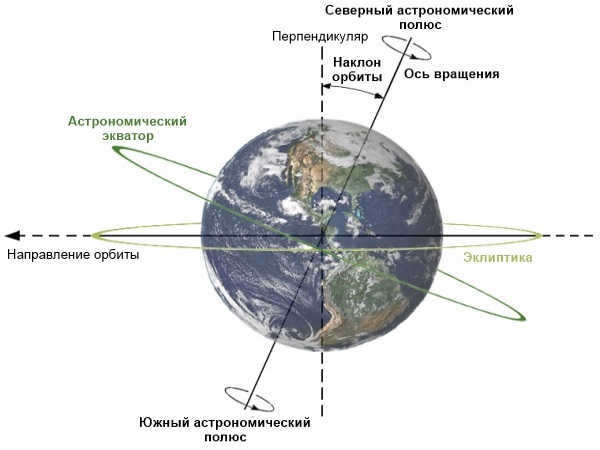
Rotation of the Earth on its Axis
The Earth rotates daily in a counterclockwise direction when viewed from above the hypothetical North Pole, which is aligned with the Earth’s actual North Pole. This rotation completes one full revolution in 23 hours, 56 minutes, and slightly over 4 seconds, determining the length of local days. Additionally, this rotation is responsible for the alternating cycle of day and night.
During the time it takes for us to orbit the center of the solar system once, the Earth completes approximately 365.25 axial revolutions, which represents the duration of the local annual period.
The concept of adding an extra day to the calendar every 4 years was proposed by scientists in the late 16th century because calculating days with fractions was not convenient.
Over the course of a century, the length of a day on Earth increases by approximately 1 millisecond due to the gradual slowing down of the planet’s rotation caused by lunar gravity. However, this small discrepancy does not currently pose any significant problems and only affects the functioning of highly precise systems and mechanisms.
In the past, the Earth has also experienced changes in its rotation rate, as evidenced by geological studies of its surface. However, these changes have always occurred within a range of +/-5% of the initial value.
The concept of rotational inertia
There is a theory suggesting that during the initial stages of its formation, the Earth was spinning rapidly and has since continued to rotate solely due to its inertia. This hypothesis can also be applied to other celestial bodies within the Solar System. However, this theory has faced opposition as it cannot fully explain the variations in the Earth’s rotational speed.
It is evident from the physics course that when attempting to connect two magnets with poles of equal charge, they will naturally repel each other. This observation forms the basis of the theory regarding magnetic fields, which asserts that because the Earth’s poles have the same charge, they orient in different directions and consequently cause the Earth to rotate.
Recently, another scientific hypothesis has been proposed: the Earth’s magnetosphere exerts pressure on the inner core in a west-to-east direction, resulting in its faster rotation around its axis compared to the rest of the planet.
Does the Sun have an impact on the rotation of Earth?
Currently, the most plausible theory is that the Sun itself influences the near-solar rotation of our planet. Scientists have been aware for a long time that the Earth’s surface shells (atmosphere, hydrosphere, upper layers of the lithosphere) are heated by solar radiation. Recent discoveries have revealed that this heating is not uniform, leading to the formation of air and sea currents.
These currents interact with the solid Earth crust, causing the planet to rotate. The continents act as turbines, determining the direction and speed of movement.
Certain continents on Earth lack the necessary solidity, leading to their continuous drifting. This drifting, in turn, has an impact on the planet’s rotation speed, either causing it to decrease or increase.
Our planet is constantly in motion, rotating both around the central point of the solar system and its own axis.
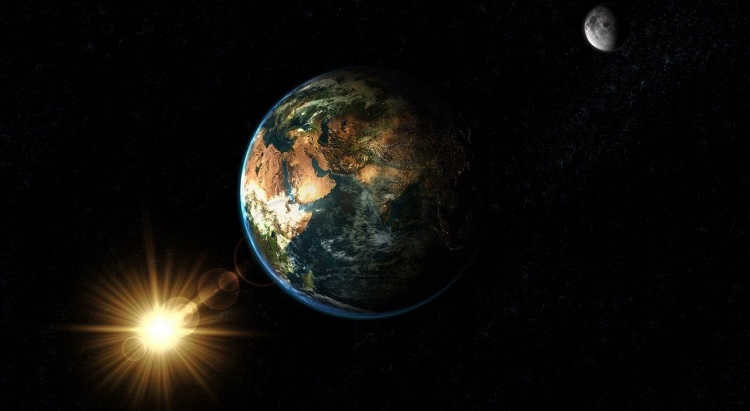
The Earth’s tilt and its axis
The Earth’s axis is an imaginary straight line that passes through the center and both geographic poles of the planet.
It is not vertical – it is tilted at an angle of 66°33′, and this is the reason for the change of seasons:
- When the Sun is at 23°27’N (above the Northern Tropic), the northern hemisphere receives the maximum amount of heat and light, marking the beginning of summer in that region;
- Six months later, the Sun rises above the Southern Tropic, located at 23°27’S. Now the southern hemisphere receives more light and heat, while the northern hemisphere experiences winter.
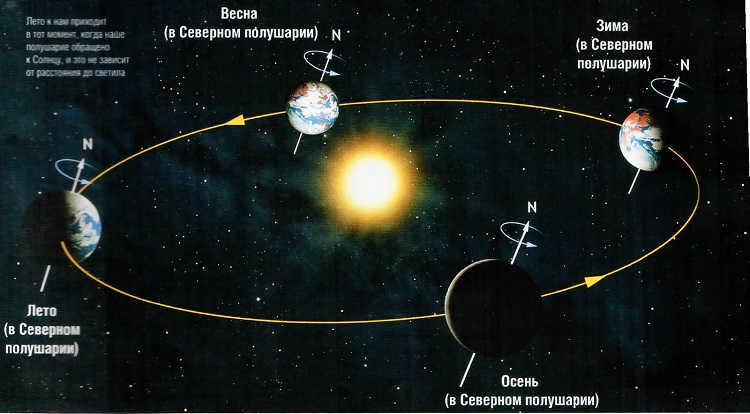
If the Earth’s axis were constantly vertical, the planet would not experience the phenomenon of seasonality: all points on the half illuminated by the Sun would receive equal amounts of heat and light.
The angle of the axis is not influenced by any external or internal factors, including the gravitational pull of the sun, moon, or other planets. However, the axis itself undergoes precession, moving in a circular conical path.
Currently, the geographical North Pole of the Earth is aligned with Polaris, but in 12 thousand years, the axis will shift in the opposite direction.
At that time, the pole will be directed towards the star Vega in the constellation Lyra. After 25,800 years, it will once again return to align with Polaris.
Furthermore, the Earth undergoes a slight drift in its axis at the poles as a result of its rotational motion, exhibiting a slight wobble and shifting in an eastward or westward direction with a velocity of approximately 10-15 cm/year. This phenomenon can be attributed to climatic variations occurring at latitudes up to 45° N and S, such as the melting of ice in Antarctica and Greenland, water depletion in Eurasia, and periods of excessive drought or rainfall in Australia.
The rotation of the Earth on its axis
A complete rotation of the Earth on its axis is known as a day and has a duration of 24 hours, more precisely 23 hours 56 minutes and a few seconds. The Earth rotates in a west to east direction. This phenomenon is responsible for the alternating cycle of day and night: daylight occurs on the hemisphere that is facing the Sun, while darkness falls on the opposite side.
As a result of this rotation, any flowing matter (such as water in rivers or air in winds) deviates from parallel lines to the equator: to the left in the southern hemisphere and in the opposite direction in the northern hemisphere. Whirlpools also exhibit different movement patterns, ranging from natural circular waterfalls to the draining water in a sink. In the northern hemisphere, water in vortices rotates clockwise, while in the southern hemisphere it rotates in the opposite direction.
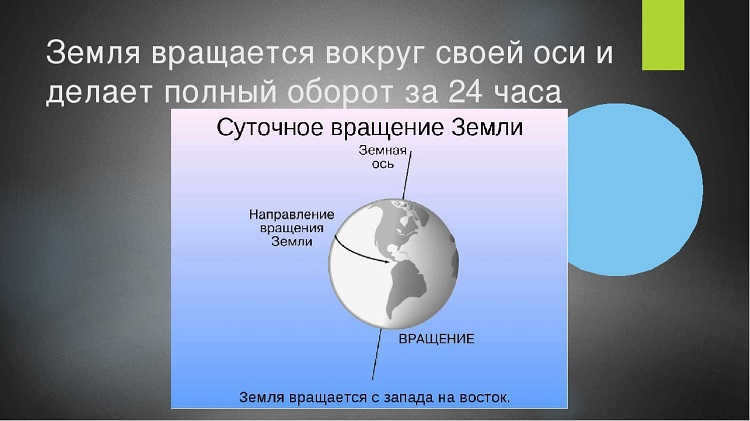
The planet’s motion on its axis causes it to rotate, resulting in a linear velocity of 465 m/s (1674 km/h) at the equator.
As you move towards the north or south, the velocity gradually decreases. For instance, at 55°N (the latitude of Moscow), the velocity is nearly halved, measuring 260 m/s.
At the North and South Poles, the linear velocity drops to 0 m/s. However, the planet’s angular velocity remains constant at 15° per hour, regardless of location.
Rotation of the Earth around the Sun
The Earth moves in an elliptical orbit around the Sun, with an average distance of approximately 149.6 million km from the center of the solar system. Its average orbital velocity is about 29.8 km/s.
The speed of the Earth’s rotation varies depending on its position in space. When it is closest to the Sun (known as perihelion), the Earth moves at a faster speed, exceeding 30 km/s. On the other hand, when it is farthest from the Sun (known as aphelion), the Earth moves at a slower speed of about 29.3 km/s.
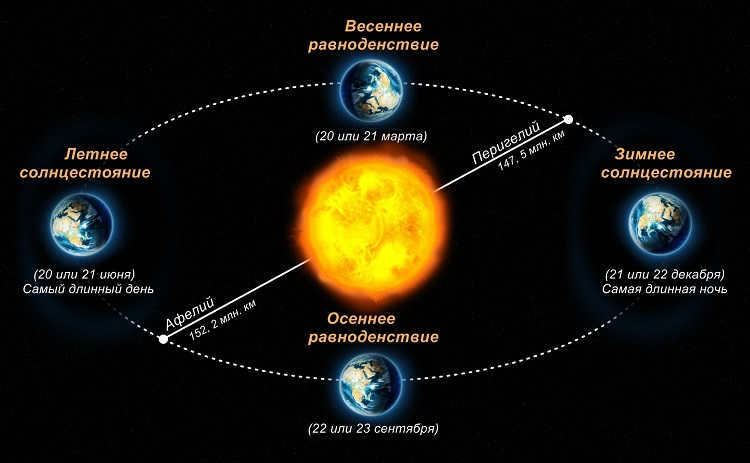
As the Earth completes its orbit around the Sun, it also completes approximately 365.25 rotations of its own. This accounts for the length of an astronomical year.
An astronomical year is different from a calendar year, which consists of exactly 365 days, each lasting 24 hours. To account for this difference, an extra day, totaling 366 days, is added to the calendar every four years.
Rotation Direction of the Earth
If we observe the solar system from an aerial perspective, where the land areas near the North Pole are directly opposite our viewpoint, we can ascertain that the Earth rotates counterclockwise.
Why we are unaware of the Earth’s movement
Humans are unable to perceive the Earth’s rotation because all objects on its surface move in parallel, in the same direction, and at the same velocity. A comparable scenario is sailing on a ship, where we do not realize that surrounding objects are also drifting along with us on the water. From our perspective, they appear motionless.
Imagine if the Earth ceases to rotate
In the hypothetical scenario where the Earth stops rotating on its axis:
- One side of the planet would be forever facing the center of the solar system, with the sun heating the soil to extreme temperatures and causing all surface moisture to evaporate.
- On the opposite side of the planet, perpetual darkness would prevail, leading to constant freezing temperatures and the formation of a thick layer of ice, potentially reaching kilometers in thickness.
- Such conditions would create an incredibly challenging environment for the emergence and survival of any form of life, including the continuity of human existence.
The duration of a day on Earth will be extended to one year, with the daylight lasting for six months and followed by a short twilight period before the planet plunges into a six-month night. The position of the sun in the sky and the occurrence of sunset and sunrise will be solely determined by the planet’s rotation around the central star, resulting in the sun rising in the west and setting in the east.
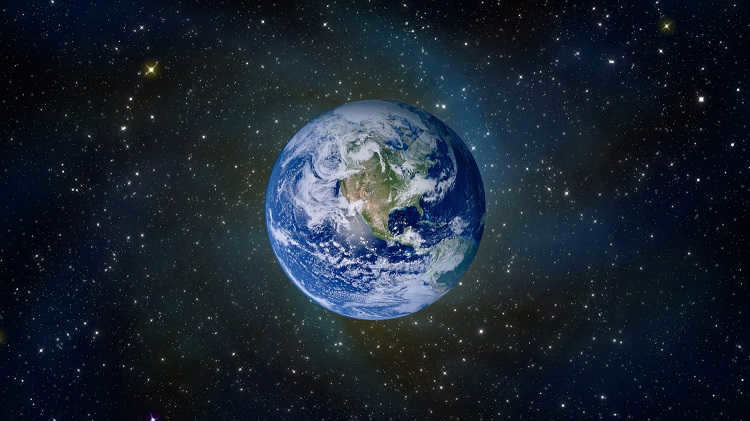
If the Earth were to come to a sudden halt, it would result in numerous adverse effects. Credit: Krpress
Given the considerable linear rotational velocity, a sudden stoppage of the planet would lead to the displacement of all structures, flora, fauna, and human beings from its surface due to the forces of inertia.
The only structures that would remain unaffected are those deeply embedded within the Earth’s solid or rocky formations. The inertia of the oceans would cause a colossal tsunami as they continue to rotate.
At present, due to centrifugal forces, the Earth is slightly flattened at the poles and has a bulge at the equator. Once it comes to a halt, this shape will change and the ocean water will flow towards the north and south, revealing the ocean floor in the equatorial area up to 30° N and S. Consequently, the Earth will take on the form of a single massive continent encircling it, with two polar water caps.
Furthermore, the Earth’s magnetic field will cease to exist, leaving us vulnerable to solar and cosmic winds – charged particles that pose a threat to all living organisms upon impact. The absence of the magnetic field will result in the disappearance of the aurora borealis.
All the aforementioned outcomes apply equally to the scenario where the Earth ceases its orbit around the Sun, albeit with even more devastating consequences. The alteration of day and night will cease to exist, resulting in perpetual darkness on one hemisphere and everlasting daylight on the other.



The combination of the Earth’s rotation around its axis with a sidereal day and around the Sun with a year results in the disparity between solar and sidereal days: the average solar day lasts exactly 24 hours, which is 3 minutes and 56 seconds longer than the sidereal day.
As the Earth spins on its axis, it causes one side of the planet to be illuminated by the Sun while the other side remains in darkness. This phenomenon is what brings about the changes between day and night. The side of the planet that is facing the Sun experiences daytime, while the opposite side, which is not being illuminated, experiences nighttime.
The planet Earth revolves around its own axis and orbits the sun, while also experiencing a tilt in its axis due to the influence of magnetic fields.

Solar system
The earth was formed through rotation, as were the other planets in our solar system. These planets originated from a swirling cloud of gas and dust in outer space approximately 4.6 billion years ago. Within this rotating cloud, the particles of matter were also spinning, colliding, and merging with one another, gradually forming larger bodies that also continued to spin.
The revolution of objects in the cosmos
Presently, the celestial bodies orbit the Sun in the same direction as the swirling nebula that birthed them. Furthermore, asteroids, which are remnants of planets, also spin on their axes as they traverse through the vastness of space. The orbital period of sizable asteroids, denoting the time it takes for them to complete one revolution on their axis, ranges from 5 to 18 hours. Over 4 billion years ago, the duration of Earth’s day was approximately 6 hours. In the distant future, it might extend to 1,128 hours.
The rotation period of Earth is 24 hours. The Earth’s circumference is roughly 40,000 kilometers. Consequently, the linear velocity of Earth’s rotation at the equator amounts to about 1,600 kilometers per hour. This is the viewpoint of William Hartman, an astronomer affiliated with the Planetary Science Institute based in Tucson, Arizona.
The Earth’s rotation is in the eastward direction. In order to take advantage of this rotation, space centers strategically locate themselves near the equator for launching artificial satellites. By launching satellites in an easterly direction, they can benefit from the Earth’s rotational speed, which is approximately 1,600 kilometers per hour.
What prevents the Earth’s rotation from decelerating?
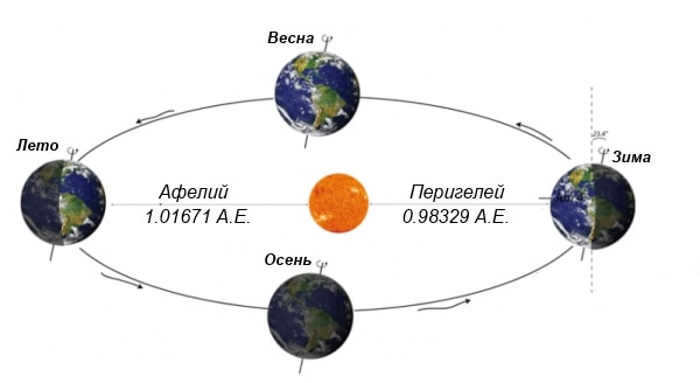
The rotation of the Earth is gradually slowing down over time. When our planet was initially formed, it was spinning at a much higher rate. At that time, the linear velocity at the equator was approximately 6,400 kilometers per hour. This means that the length of a day was only 6 hours. If there were inhabitants on Earth during this period, they would have witnessed the Sun rise and set within a span of 3 hours, leaving them with just a three-hour night for sleep.
On the other hand, the duration of a day on Mercury is approximately two Earth months. In contrast, the massive planet Jupiter rotates so rapidly that a day on it is less than 10 hours long. Meanwhile, Mars has a day that is similar to ours, lasting 24 hours and 37 minutes.
The Moon was once positioned much closer to the Earth than it currently is, while also steadily moving away from it. The gravitational pull exerted by the Moon on the Earth results in the rise and fall of ocean tides. Over time, these tides gradually slow down the Earth’s rotation. Every century, the length of a day increases by half a minute. Eventually, the day will extend to 1128 hours. However, as a result of gravitational forces and tides, the Moon will begin to draw closer to the Earth again, causing its rotation speed to once more accelerate.
What could occur if the Earth comes to a halt – an intriguing video
If you happen to come across any mistake, kindly select the text snippet and hit Ctrl+Enter.
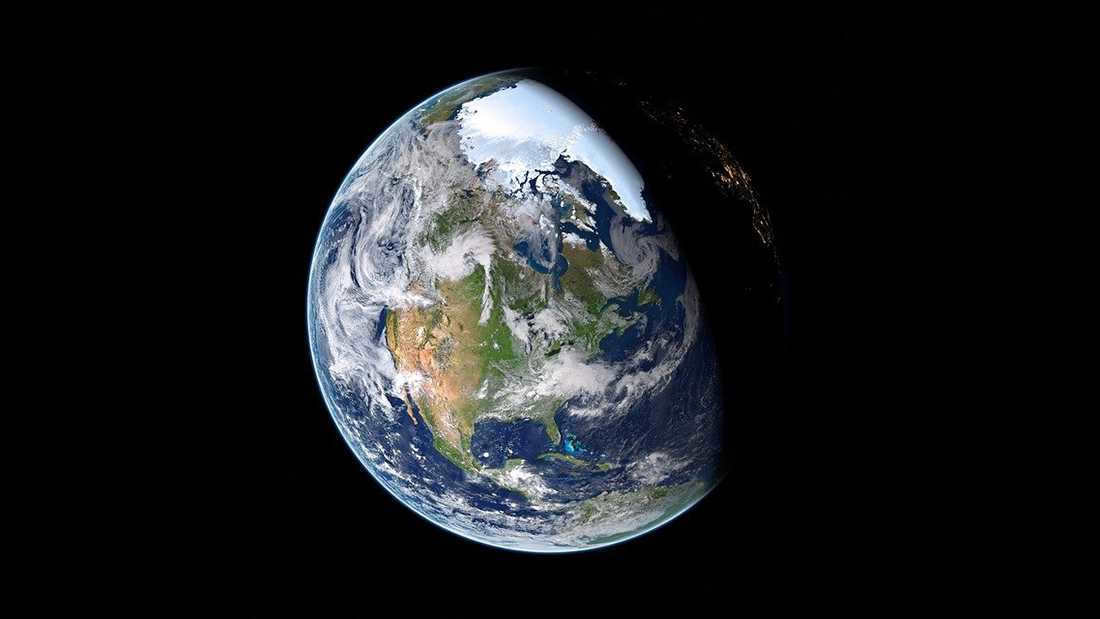

The Earth may appear immense to us, but in reality, it is just a tiny speck in the vast expanse of the universe. However, it is on this small speck that the miracle of life emerged. It is widely known that our planet is constantly in motion. We learn from an early age that the Earth never stands still. The famous saying “Movement is life” holds true not only for living beings, but also for our planet. It is this perpetual motion of the Earth that gives rise to the alternating cycles of day and night across every corner of the globe.
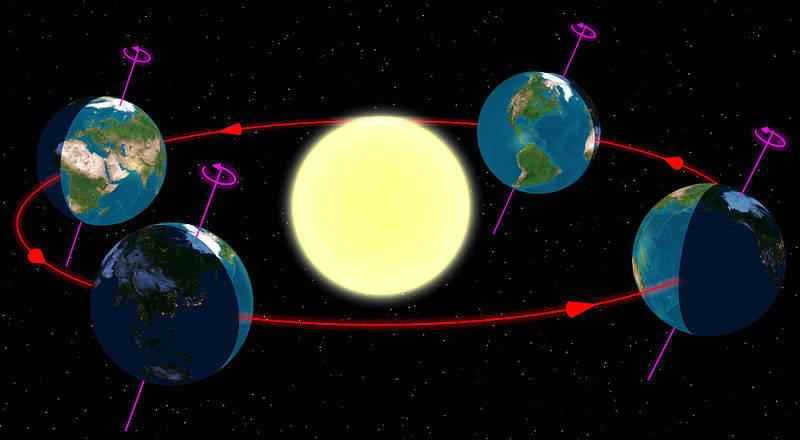
The term “axial rotation of the Earth” refers to the Earth’s movement around its axis. This movement is fully experienced by humans. The Earth rotates from west to east, or counterclockwise if observed from the North Pole.
The Earth’s axis, which is an imaginary straight line, passes through the center and the geographical poles of the planet. The tilt of this axis is responsible for the changing seasons on Earth:
- When the Sun is above the Northern Tropic, the northern hemisphere receives the maximum amount of light and heat, resulting in summer;
- After six months, the Sun is above the Southern Tropic, and the southern hemisphere receives more light and heat, leading to winter in the northern hemisphere.
It can be inferred from this that if the Earth’s axis were positioned at a 90-degree angle, there would be no changes in seasons on the planet. This is because all points on the half of the globe illuminated by the Sun would receive an equal amount of light and heat. It is important to note that the location of the axis is not influenced by any external or internal factors.
Every individual has at some point wished for more than 24 hours in a day. The period of rotation around the axis is approximately 24 hours, or more precisely, 23 hours 56 minutes and 4 seconds. This motion of the axis is also known as diurnal.
As it moves, the Earth’s axis traces out cones in space.
Impact of Earth’s Rotation on Various Aspects
Here are some of the consequences resulting from the rotational movement of our planet:
- The Earth’s shape is flattened at the poles and takes the form of an oblate spheroid;
- The occurrence of day and night. As the Earth spins around its axis, different parts of the planet are either facing the Sun or away from it. This leads to the presence of daylight on one side and darkness on the other. This phenomenon contributes to the establishment of a circadian rhythm in nature.
- The Coriolis force manifests itself as the deflection of moving bodies due to the Earth’s rotation around its axis. In the Northern Hemisphere, bodies are deflected to the right, while in the Southern Hemisphere, they are deflected to the left. This phenomenon can be observed in the movement of air masses, river currents, and ocean currents.
- Tides occur as a result of the Earth’s rotation around its axis and the gravitational pull of the Moon and the Sun. These tidal phenomena occur twice a day and are present in all parts of the Earth, but they are most noticeable in the hydrosphere.
What is the reason behind the Earth’s axial movement?
According to the prevalent theory, the Earth’s axial movement is a result of processes that trace back to the formation of planets. During this period, space dust formed planetary embryos, which attracted other celestial bodies. Some of these bodies were larger than the Earth, while others were smaller. When the Earth collided with these bodies, it started rotating around its axis. Subsequently, the Earth continued its rotational motion due to inertia.
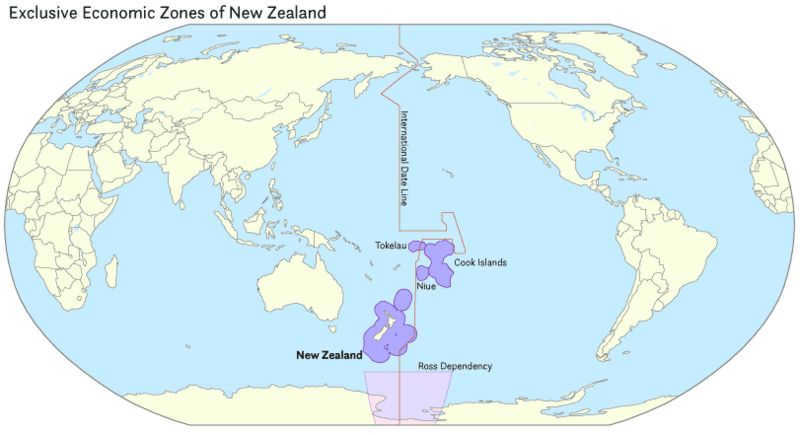
The explorer Magellan had the belief that the Earth undergoes rotation on its axis in an eastward to westward direction. When he completed his circumnavigation of the globe in this manner, he observed one fewer sunrise than what was witnessed in Europe at the same time. In order to prevent such confusion during future voyages around the world, the concept of the date line was introduced.
This line does not extend across many landmasses. It primarily aligns with the 180 degree meridian. The date line connects the Earth’s two poles and only intersects with land in Antarctica. As a result, when traveling around the globe, there is no need to add or subtract a day.
This line represents a boundary where the date on the calendar changes, while the time remains constant. For instance, if it is already January 1st to the west of this line, it will still be December 31st to the east. However, the clocks on both sides will display approximately the same time.
The dates change when crossing this line. When traveling from east to west, one day is added to the calendar date. Conversely, when moving in the opposite direction, one day is subtracted. In reality, there are no physical laws governing the location of this date change line. It exists solely for the purpose of facilitating communication between different countries and states. The crossing of this border is akin to a seasonal adjustment of clocks.
What is the reason behind our inability to sense the Earth’s rotation?

During the rotation of the Earth, there are only two fixed points: the North and South Poles. By connecting these points with an imaginary line, we can establish the Earth’s axis of rotation. This axis is not perpendicular to the Earth’s orbit, but rather inclined at an angle of 23.5 degrees. As the Earth rotates, all objects move in parallel to each other along this axis.





